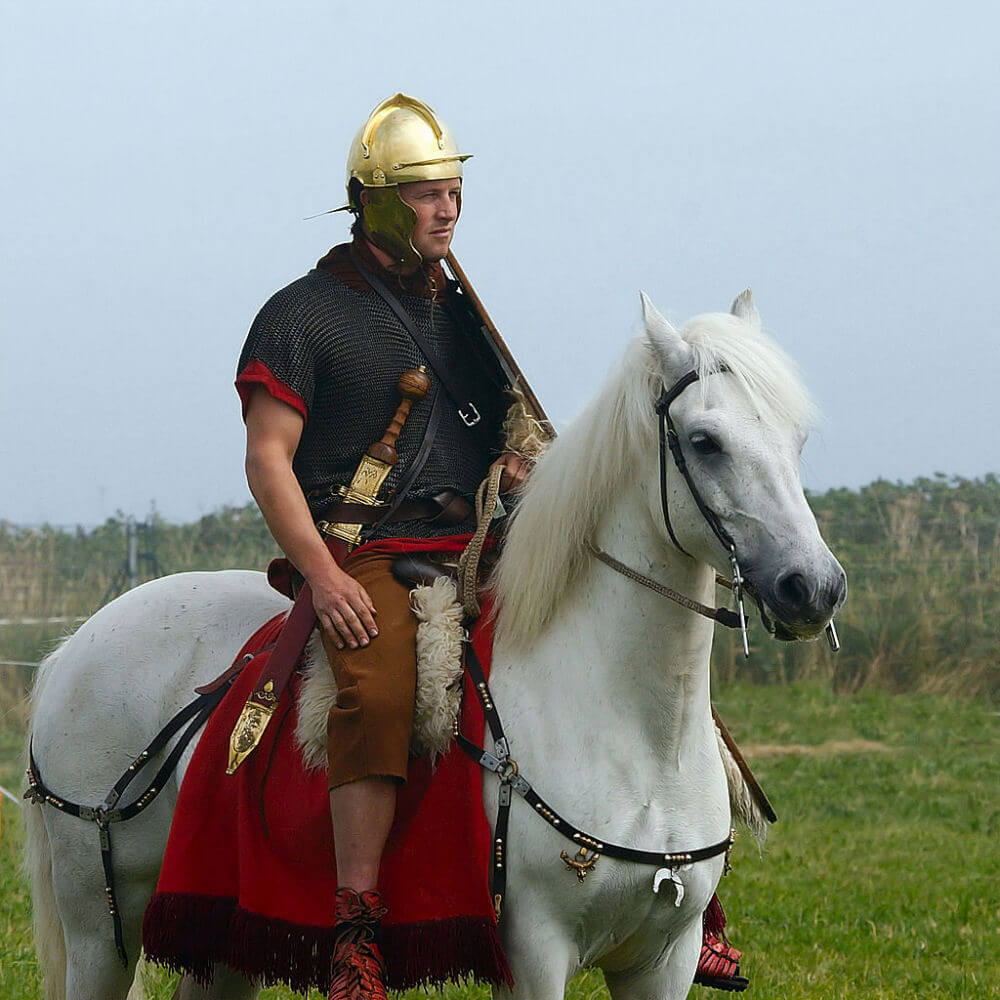Ancient Roman Cavalry

As the Romans were never considered exceptionally good horsemen, and the role of the cavalry not as important in the Roman thought process, the Equitatus was generally made up of non-Roman horsemen.
While they would play an important part of legionary tactics, the Roman Cavalry was considered secondary, and would remain the weakest part of the Roman Army until the very late Imperial period.
Generally, the cavalry was used as light skirmishing troops and mounted archers whose job was to patrol, act as scouts and messengers and to provide a mobile defensive screen while the legion was massing in battle array.
As in all armies throughout history, the mounted trooper was also very effective in chasing down and harassing a fleeing and panicked enemy force.
Basic Organization of the Roman Cavalry
The typical Auxillary cavalry unit (Ala Quingenaria) was broken down as follows:
- Turmae: The smallest basic unit of cavalry. One Turma consisted of 32 troopers or Eques Alaris. The Turmae were under the command of a Decurion.
- Alae: Meaning "wing" the basic alae was composed of 512 men, a total of 16 turmae.
- Ala Milliariae: A larger formed unit with the same structure. It was composed of up to 32 alae or roughly up to 1,000 troopers.
- Equites Legionis: These were the cavalry units attached directly to the legion and were considered regular legionaries of immunes rank. Originally they consisted of 120 men, but may have been upwards of 1,000 men like the Ala Milliariae. Generally this unit would fall under the command of a Centurion or an Optio.
- Cohortes Equitatae: These units were composed of a mix of infantry and cavalry but were generally only organized when the need arose.
- Cohors Quingenaria: Composed of 120 infantry and 380 cavalry.
- Cohors Milliaria Requitata: Composed of 240 infantry and 760 cavalry.
- Equites Singulares: Both the emperor and provincial governors could have cavalry contingents as bodyguards. Those protecting the emperor were called Equites Singulares Augusti, and are explained further in the Praetorian Guard section.
Types of Roman Cavalry
- Lancearii or Antesignani: The Roman light cavalry, the Equites Legionis was generally this type of trooper.
- Conttarii: These troop types were created under the reign of Trajan, probably to counter the cavalry of the Sarmatian people, and carried the heavy lance (contus).
- Cataphractii or Clibanarii: This heavy cavalry was developed in the east and probably first appeared in Roman service under Hadrian. They were completely armored from head to toe in order to counter archers.
- Sagittarii: Mounted archers.
Roman Cavalry Ranks
The following list indicates a general chain of command and various titles within the cavalry:
- Praefectus Alae or Praefectus Equitum: Cavalry commander, could be either Roman or a non-Roman.
- Decurion: Commanded a single turmae.
- Duplicarius: Second in command to the Decurion.
- Sesquiplicarius: Third in command to the Decurion.
- Eques or Eques Alaris: A cavalryman or auxiliary cavalryman.
The cavalry also maintained several positions of the infantry like the principales.
Some other titles in no particular order:
- Centurio Exercitator: Cavalry training officer.
- Eques Speculator: A mounted scout.
- Eques Stablesianus: Cavalry stablehand.
- Eques Sapsarius: Mounted medical personnel.
Basic Organization of the Auxiliary Infantry
While the legion itself was essentially heavy infantry of Roman citizens, the auxilliaries were non-citizens, and, apart from cavalry, were used as light infantry and missile troops.
The basic unit structure is explained above in the cavalry section.
Auxiliary Infantry Ranks
- The Praefectus Alae of a 1,000-man strong cavalry unit was the highest rank attainable in the auxiliary, followed by the same title of a 500-man cavalry unit.
- Tribunus Cohortis: A commander of a 1,000 man strong infantry or mixed unit.
- Praefectus Cohortis: Commander of a typical 500 man unit composed of mixed troops.
The rank and file fell under the command of the Centurions, along with a similar command structure to that of the regular legion.
Did you know...
Under Caesar, legions did not have cavalry integrally assigned, as had been the case previously. Roman citizens able to possess, equip and feed horses were now members of the officer class, so that Caesar's cavalry was ordinarily furnished by friendly, allied or conquered states.



